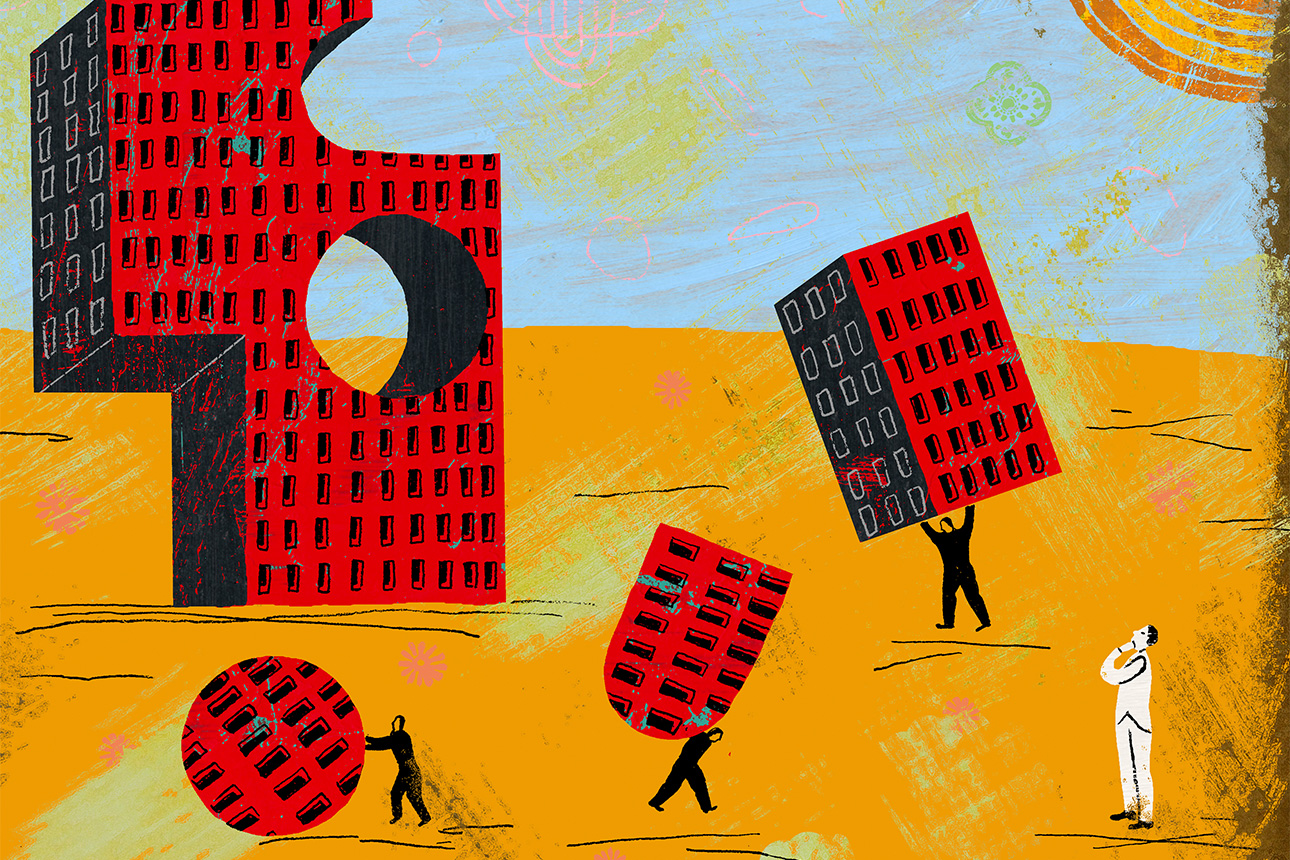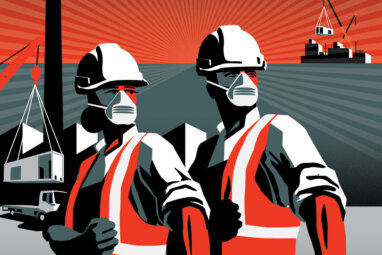Redesigning the Post-Pandemic Workplace
Work as we know it is forever changed by COVID-19. Now is the time for managers to envision the office that employees will return to.
Topics
Frontiers

Image courtesy of Ken Orvidas/theispot.com
The world has experienced widespread disruption over the past year as a result of the COVID-19 pandemic. With the successful development and distribution of a COVID-19 vaccine, the timeline for when the so-called next normal will arrive is clearer. Leaders should begin to take steps to consider what the workplace will look like when it arrives.
There is no going back to the prepandemic workplace. Organizations and individuals have had no choice but to discover new ways of working. Many have reported successfully implementing years’ worth of digital transformation plans over the course of a few months. For example, mortgage loan company Freddie Mac implemented remote building inspection, and many health care providers pivoted rapidly to telemedicine. Even companies that needed to maintain a significant colocated workplace used digital innovations to improve employee and customer engagement and safety. For example, Hitachi adapted sensors to monitor social distancing in factories, and many restaurants quickly adopted virtual ordering and delivery services. Managers should begin asking themselves how they can build on such innovations to further transform their businesses instead of planning a return to ways of working that were becoming outdated and obsolete even before the pandemic.
The pandemic is not the only disruption we have experienced in the past year. It has also been a time of political divisiveness, social unrest driven by racial inequality, and ongoing digital disruption, to name but a few. In our forthcoming book, The Transformation Myth: Leading Your Organization Through Uncertain Times, we argue that the end of the pandemic will almost certainly not mean an end to disruption. Over the next few months, leaders would be well served by taking the opportunity to learn how to apply the innovations and advances implemented in recent months and developing an approach for ongoing workplace reinvention that is more resilient to all types of disruption.
Maximize the Benefits of Both Remote and Colocated Work
The anticipated gradual return to colocated work in the coming months provides opportunities to experiment with hybrid ways of working. Returning to the office strategically, by focusing first on the activities best performed in person and, in the process, evaluating the effectiveness of both remote and colocated work, gives managers the ability to critically consider the ways in which a hybrid workplace might be more effective.
The pandemic taught us that remote work can be highly effective — to a degree. Employees are often more productive when they don’t have to spend time on a daily commute. Meetings may be more frequent but tend to be shorter. Virtual work also allows people to collaborate across geographic, physical, and organizational boundaries in novel ways. But our recent research has shown us that the past few months of widespread remote working have also had some significant drawbacks. Our interviews with over 50 executives between April and November 2020 about their experience of leading their organizations through the pandemic uncovered challenges in the following areas:
- Innovation. Although remote collaboration among colleagues who regularly engaged with one another worked well, serendipitous connections with others dropped off precipitously. Research has shown that these weak ties are often critically important to innovation and knowledge sharing in organizations.
- Starting new projects. Remote work had little impact on workers’ ability to finish big group projects that were already underway. Relying on virtual collaboration to initiate new projects, however, was an order of magnitude more difficult in terms of challenges and stressors. This finding underscores the value of remote work but raises questions about relying on it exclusively for a long-term workplace strategy.
- Culture. Several people we interviewed said that establishing and maintaining organizational culture is difficult, if not impossible, in a virtual setting. Many of the cues to organizational culture that the physical workplace provides, such as the design of the office and how people dress, disappear with virtual work. The lack of a strong sense of culture is a particularly acute problem with respect to onboarding new hires.
- Mentoring and coaching. Employees, particularly younger ones, received less mentoring and coaching during the shift to remote work than they did before the pandemic. If people don’t get the feedback they need to develop into more mature employees and leaders, this deficiency could negatively affect career development over time.
Leaders should spend the next few months planning how to combine the best aspects of remote and colocated work. Ben Waber, president of the workplace analytics company Humanyze, shared with us early data from Asia that suggests that a little colocation can go a long way toward reducing the limitations of remote work. Employees who returned to the office only one or two days per week increased the number of serendipitous connections by about 25%, Waber said. Yet we also expect that decisions about balancing remote and colocated work will affect, and be affected by, a broader set of factors, such as school reopenings and public transportation load, which have also been affected by the pandemic.
Leaders should consider the following as they envision the reinvented workplace:
Enabling flexibility in usage. The pandemic has underscored the importance of organizational nimbleness, and organizations can design physical workplaces to support it. Office furniture manufacturer Steelcase is now developing product lines designed for on-the-fly adaptation, according to Sara Armbruster, the company’s vice president of strategy, research, and digital transformation. Different office configurations could be employed depending on whether a group is brainstorming, hosting a workshop, or conducting a daily stand-up meeting.
However, managers will need to be mindful of employee preferences as they rethink how a space is configured. Janet Pogue McLaurin of architecture and design company Gensler told us that 61% of U.S. employees still want a dedicated desk in the workplace, even if it means they need to come to the office more often. This number may change as the pandemic wanes, but managers might consider ways to create a sense of employee ownership of personal space amid this flexibility or to establish a temporary sense of ownership through a booking or reservation system.
It also may be that office space configurations change seasonally, perhaps with decreased workplace density during winter months to promote employee health. For example, the health insurer Humana took advantage of mild weather in Louisville, Kentucky, and created pop-up outdoor offices in partnership with local parks to provide safer workspaces during COVID-19. The company brought in tents, socially distanced work areas, Wi-Fi, restrooms, and food trucks to allow small numbers of employees to work together in safer ways. The company may explore whether these outdoor pop-up workplaces have additional benefits and retain them as a part of its workplace strategy for the future.
Continuing to evolve virtual work. Organizations should continue to experiment with virtual work amid the gradual return to the workplace. First, most people have been working virtually for less than a year. While that amount of time seems substantial, it is unlikely that employers have discovered the full range of opportunities that virtual work provides during that period. For example, many companies are just beginning to explore the possible benefits of more advanced asynchronous collaboration tools, and they are only scratching the surface on the myriad ways to leverage the data generated by digital collaboration to improve workplace performance.
Second, the nature of virtual work will change when organizations can combine it with colocated work. Rather than needing to perform all work remotely, organizations can begin to explore more deeply the processes and practices that can evolve virtual work to optimize organizational benefits. For example, the pandemic uncovered important deficiencies with how companies previously used digital tools. Several interviewees who were long-term remote workers reported feeling more included once everyone else on a team was also remote. Meetings in which some participants are physically present together while others are remote may be worse than either exclusively colocated or purely virtual meetings. Managers who continue to run hybrid meetings should experiment with new ways to promote inclusion of remote participants.
Digitally supporting colocated work. If people have the option to work from home, it seems likely that they will use this time to engage either in individual focused work or in remote meetings. When employees decide to make the effort to come into the office, it will be to engage in the types of tasks that require in-person interactions. Digital tools can help maximize in-person interactions by identifying who will be in the office at the same time. These apps could begin to incorporate more advanced recommendation features, suggesting new connections using organizational network analysis among those also at the office. This increased digitalization and analytics can also help improve organizational knowledge flows.
While digital tools create opportunities to work in new ways, organizations should also look further into the future and consider how these tools might be applied to support changes in employee behavior as work is automated. Managers also must continue to rethink how they manage performance as more employees adopt a hybrid model with both remote and colocated work.
Discovering Workplace, Workforce, and Work
Rethinking the workplace also opens up new opportunities for rethinking the workforce and, ultimately, work itself. When your organization is not limited to a colocated workplace, the idea of whom you can include in the workforce expands. For example, many Silicon Valley companies have indicated that they are able to hire more-diverse employees when their potential talent pool is not limited to those who want to live in the San Francisco Bay Area. It also creates opportunities for rethinking work itself by creating new ways to integrate automation and analytics to digitally transform many aspects of work.
The workplace, workforce, and work of the future will be fundamentally different as a result of the pandemic. The gradual emergence from this disruption provides an unprecedented opportunity to explore and experiment. Leaders must learn to continually reinvent the future of work, and now is the time to begin discovering how to bring that future about.









Comments (2)
Alfredo Castrejon
Jose Santiago